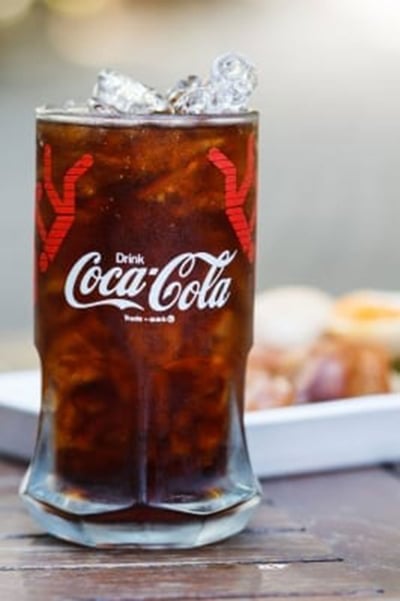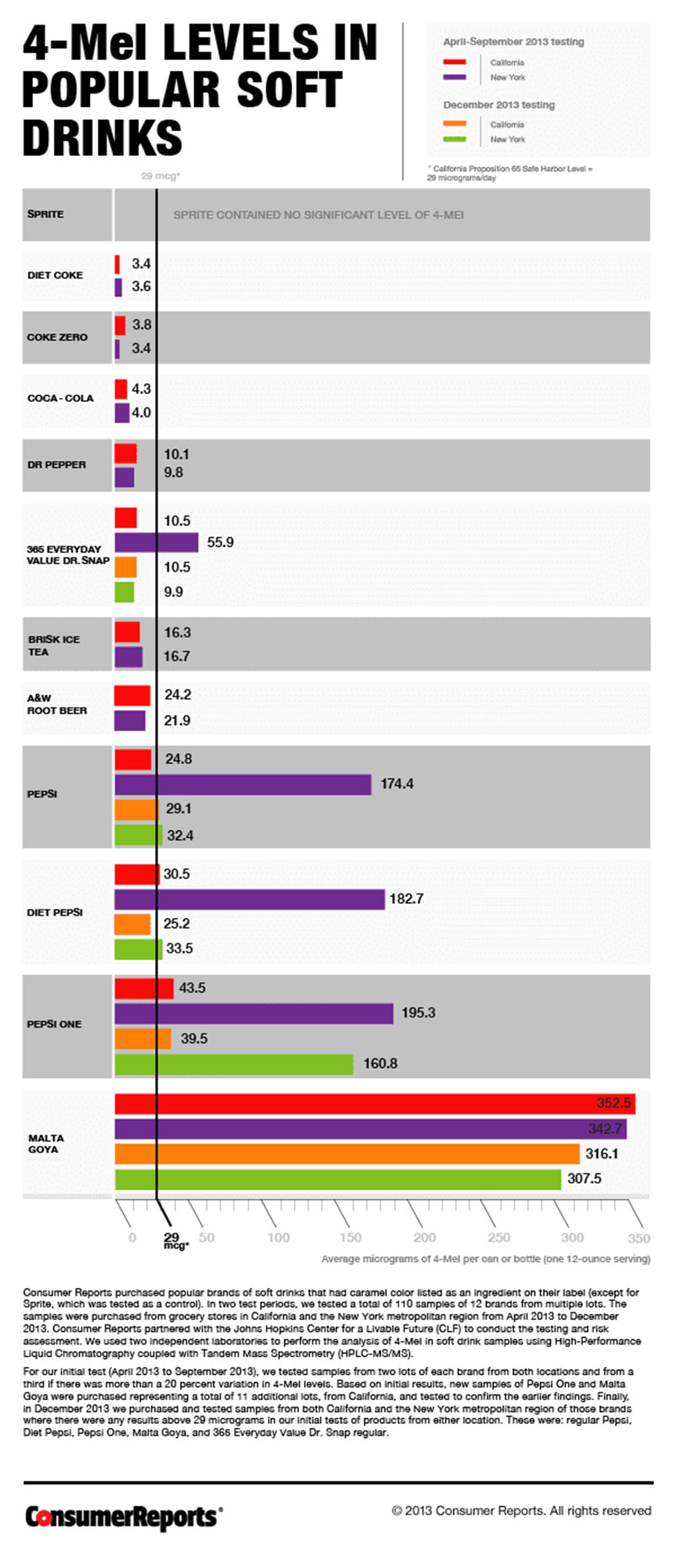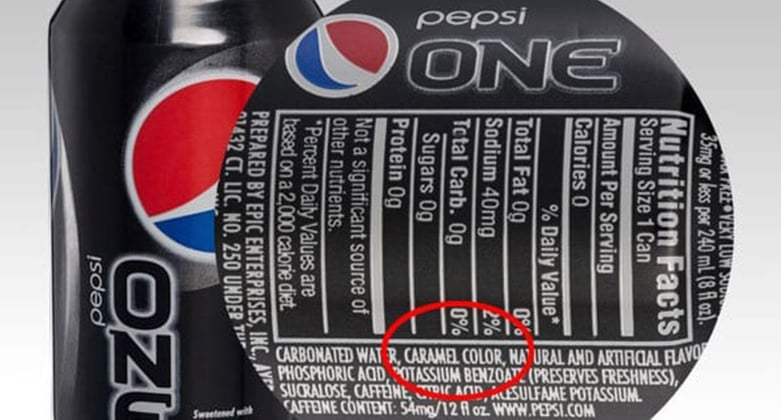We already know that both sugared and diet sodas aren’t good for us, but a study done by a major magazine says the caramel coloring used in many popular soft drinks could be carcinogenic.
The UMHS Pulse looks at the study by Consumer Reports magazine on how caramel coloring in many sodas could be linked to cancer.
Caramel coloring is added to soft drinks and certain foods to give them a brown hue. As Consumer Reports pointed out, “In no way does it resemble real caramel. Some types of this artificial coloring contain a potentially carcinogenic chemical called 4-methylimidazole (4-MeI).”
Caramel coloring isn’t just in soft drinks. It is one of the most widely used food colorings globally, based on a 2013 report for market research firms Mintel and Leatherhead Food Research.
The magazine said under the Proposition 65 law in California, “any food or beverage sold in the state that exposes consumers to more than 29 micrograms of 4-MeI per day is supposed to carry a health-warning label.”
Consumer Reports tested 12-ounce samples of Pepsi One and Malta Goya, a beverage popular with Latino Americans. Both drinks contained more than 29 micrograms of 4-MeI in a can or bottle. The magazine has asked California’s Attorney General to investigate whether the levels of the artificial coloring are dangerous to consumers.
“There’s no reason why consumers should be exposed to an avoidable and unnecessary risk that can stem from coloring food brown,” says Urvashi Rangan, Ph.D., toxicologist and executive director of Consumer Reports’ Food Safety & Sustainability Center. “Manufacturers have lower 4-MeI alternatives available to them. Ideally there would be no 4-MeI in food.”
Risks & Soda Makers’ Response
Consumer Reports said a 2007 federal government “concluded that 4-MeI caused cancer in mice and the International Agency for Research on Cancer determined the chemical to be ‘possibly carcinogenic to humans’ in 2011.”
Although there is no government limit for 4-MeI levels in foods and drinks, two years ago California started requiring manufacturers to label any product sold in that state with a cancer warning “if it exposes consumers to more than 29 micrograms of 4-MeI per day.”
The magazine said the California Office of Environmental Health Hazard Assessment “used 29 micrograms as the cut off point because that’s the level they determined poses a one in 100,000 risk of cancer—that is, no more than one excess cancer case per 100,000 people who are exposed to that amount daily for a lifetime.’”
Consumer Reports spoke to a representative from PepsiCo and asked if the beverages sold in California complied with state laws.
“When the regulatory requirements changed in California, PepsiCo moved immediately to meet the new requirements,” a PepsiCo spokesperson told the magazine. PepsiCo said “reformulated products containing lower levels of 4-MeI” will be available throughout the USA in February 2014.
 The following are highlights from Consumer Reports and the study on 4-MeI:
The following are highlights from Consumer Reports and the study on 4-MeI:
- After the magazine informed PepsiCo of the test results, the company issued a statement that said that Proposition 65 is based on per day exposure and not exposure per can. It also cited government consumption data that shows that the average amount of diet soda consumed by people who drink it is 100 milliliters per day, or less than a third of a 12-ounce can. For that reason, they believe that Pepsi One does not require cancer-risk warning labels—even if the amount of 4-MeI in a single can exceeds 29 micrograms.”
(Photo, inset right) COKE HAS LOWEST 4-MEI LEVELS: Coke, Diet Coke & Coke Zero has under 5 milligrams of 4-MeI per can, Consumer Reports said. Photo: FreeDigitalPhotos.net
- “Consumer Reports says there is analysis of government data that shows higher levels of daily consumption of soft drinks generally. ‘No matter how much consumers drink they don't expect their beverages to have a potential carcinogen in them. And we don't think 4-MeI should be in foods at all. Our tests of Coke samples show that it is possible to get to much lower levels,’ says Dr. Rangan.”
- “Consumers Union, the policy and action arm of Consumer Reports, is taking several actions. First, we are alerting the California Attorney General’s office of our test findings regarding Pepsi One and Malta Goya. We are also petitioning the Food and Drug Administration (FDA) to set a federal standard for 4-MeI and in the meantime to require manufacturers to list the type of caramel color they use on their products’ ingredient lists. That’s important because there are four types of caramel coloring. Only the two made with ammonia compounds can contain 4-MeI. However, manufacturers can use the general term ‘artificial color’ interchangeably with ‘caramel color.’”
- “In a statement from the agency, the FDA said it does not believe that 4-MeI from caramel color at levels currently in food pose a risk. However, they appreciated Consumer Reports’ tests and are currently doing their own tests of foods, including sodas, for 4-MeI. They are also reviewing new safety data on 4-MeI to determine what, if any, regulatory action needs to be taken.’”
- “Consumer Reports tested 81 cans and bottles of various popular brands of soft drinks from five manufacturers between April and September 2013. We purchased the products from stores in California and the New York metropolitan region. In December 2013, we bought and tested 29 new samples, again from the same areas, of those brands that had initially tested above 29 micrograms per can or bottle in either location.”
- “While our study was not large enough to recommend one brand over another, both rounds of testing found that the level of 4-MeI in the samples of Pepsi One and Malta Goya purchased in both locations exceeded 29 micrograms per can or bottle. The products we purchased in California did not have a cancer-risk warning label.”
- “In our initial testing, some of the other brands we bought in California had average levels around or below 29 micrograms per can, but the New York area samples of those same brands tested much higher. In our second test, though, the levels in the New York samples had come down. For example, regular Pepsi from the New York area averaged 174 micrograms in the first test and 32 micrograms in the second. ‘The fact that we found lower amounts of 4-MeI in our last round of tests suggests that some manufacturers may be taking steps to reduce levels, which would be a step in the right direction,’ says Dr. Rangan.”
- "On average, three of the brands—Coke, Diet Coke, and Coke Zero—came in under 5 micrograms per can in our tests, a level Consumer Reports’ experts believe is more acceptable. Sprite, a clear soda that was tested as a control, showed no significant levels of 4-MeI.”
Dr. Rangan of Consumer Reports said the USA should implement what some countries abroad are doing to combat the problem.
“Europe has labeling requirements and consumers in the United States should have the right to make an informed choice about what they are drinking and eating,” Dr. Rangan said.
Dr. Rangan suggested reading labeling on products carefully and to reduce or halt consumption of beverages and food products that contain caramel or artificial color.

CRO CFA Caramel Color Chart. Chart: Courtesy of Consumer Reports
(Top photo) CARCINOGENS IN COLA? Caramel coloring might cause cancer, Consumer Reports claims. Photo: Courtesy of UPI.com
About UMHS:
Built in the tradition of the best US universities, the University of Medicine and Health Sciences focuses on individual student attention, maintaining small class sizes and recruiting high-quality faculty. We call this unique approach, “personalized medical education,” and it’s what has led to our unprecedented 96% student retention rate, and outstanding residency placements across the US and Canada. UMHS is challenging everything you thought you knew about Caribbean medical schools.

Scott is Director of Digital Content & Alumni Communications Liaison at UMHS and editor of the UMHS Endeavour blog. When he's not writing about UMHS students, faculty, events, public health, alumni and UMHS research, he writes and edits Broadway theater reviews for a website he publishes in New York City, StageZine.com.
















